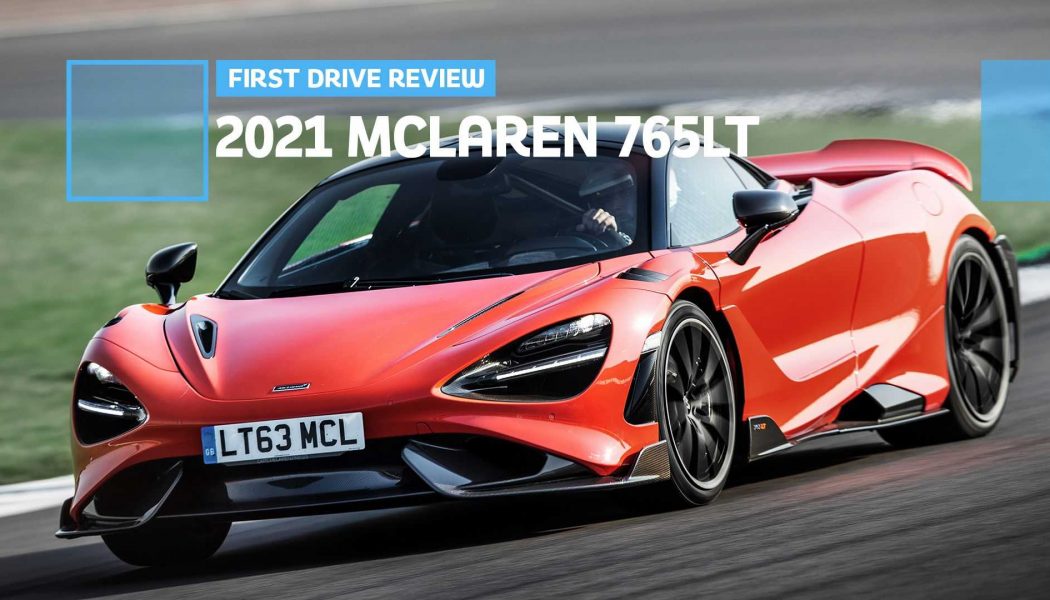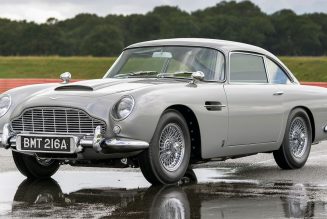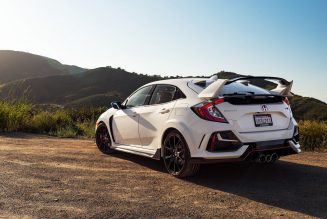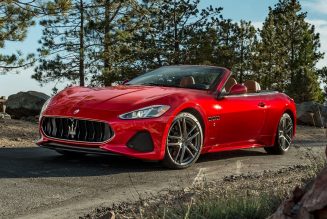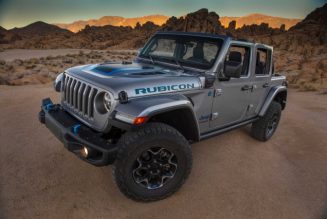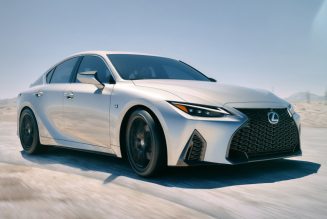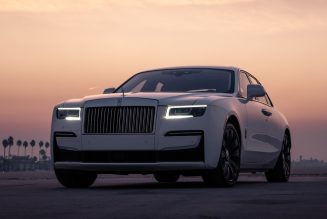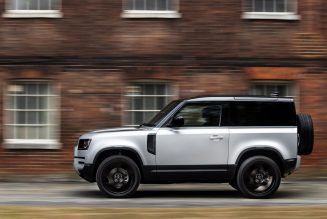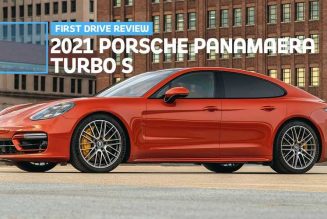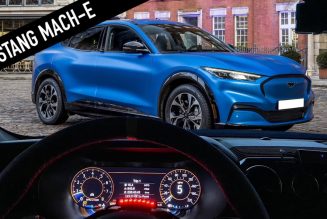Sixth gear, nudging 170 mph, and Stowe Corner, Silverstone’s deceptively fast right-hander, is closing fast. Stay off the brakes … Stay off the brakes… Now! The steering wheel squirms slightly and the McLaren 765LT‘s nose dips sharply as the four 15.4-inch carbon-ceramic rotors are clamped by Brembo calipers. Flick the left paddle. Fifth gear. Flick it again. Fourth gear. Ease the pressure on the brake pedal just a touch and turn in.
Feel the weight transfer keep the front axle planted all the way into the apex. Marvel at how faithfully the rear axle follows. Off the brake pedal completely and gently, oh so gently, squeeze the throttle and find the balance. Patience … Patience … The Trofeo Rs are nibbling, mouse-like, at the limits of adhesion. Clip the hungry curb that jumps out on the left on the exit, open the steering, and go to full power.
Oh yes, a conversation with the 2021 McLaren 765LT is a wondrous thing.
It talks to you, this McLaren, the chassis and steering and powertrain and brakes engaging in a deeply meaningful running dialog that lets you know exactly what is happening, and why, all the time. There is perhaps no other roadgoing supercar in the business where the relationship between human and hardware is as expressively intimate as the 765LT.
The 765LT is the fifth McLaren of the modern era to carry the storied LT moniker, which signifies it has been designed to be quicker, lighter, sharper, more engaging to drive, and more exclusive to own than the car upon which it is based—in this case the fast and user-friendly McLaren 720S. LT is, of course, McLaren shorthand for Longtail, a designation first used in 1997 for a race version of the Gordon Murray-designed McLaren F1 that had extended rear bodywork for improved aerodynamics.
The 765LT’s rear bodywork is indeed longer than that of the 720S—by precisely four-tenths of an inch, courtesy of a new rear bumper and a full-width active rear spoiler that helps increase downforce on the rear axle by 25 percent and flips to a near vertical position under braking to help slow and stabilize the car. And despite the name, the 765LT is, ironically, gains more length at the nose. Relative to the 720S, a new front splitter, front bumper and front floor extend the front overhang by 1.6 inches to help boost downforce on the front axle.
Suspension changes include unique LT-spec springs and damper hardware, new software for the linked hydraulic active suspension, and a lower front ride height. The front track has also been widened and roll stiffness increased. The braking system is straight from the wild, brutalist, barely street-legal McLaren Senna and is capable of bringing the 765LT to a standstill from 124 mph in less than 360 feet, McLaren says. The standard tire is a specially developed, track-friendly Pirelli P Zero Trofeo R, 235/35 ZR19 on the front axle and 305/30 ZR20 at the rear.
LT-specific upgrades to the mid-mounted 4.0-liter twin-turbo V-8 include the addition of forged aluminum pistons and three-layer head gaskets from the Senna, along with a higher-flow fuel system and a new low-back-pressure titanium exhaust that ends dramatically with four high-mounted outlets at the center of the car. These hardware changes, combined with a recalibrated engine management system, have boosted the engine’s output to 755 hp and 590 lb-ft of torque, increases of 45 hp and 22 lb-ft over the 720S. The seven-speed dual-clutch transmission has lower ratios that help deliver 15 percent quicker in-gear acceleration and enable the 765LT to hit its 205-mph top speed in top gear.
The 765LT not only boasts more power and torque than the 720S, it weighs less, too. A meticulous mass reduction program has helped trim 176 pounds from what is already the lightest car in the segment. Forged alloy wheels secured by titanium bolts have saved just over 48 pounds, and replacing the standard seats with the ultra-light, one-piece race seats from the Senna accounted for another 40 pounds. Changes to the way the carbon-fiber tub is built in McLaren’s specialist facility in Sheffield, England, have shaved almost 32 pounds from the overall body structure. The titanium exhaust is 40 percent lighter than a comparable steel system.
Order a 765LT in the lightest possible specification, and it will come in at just under 3,000 pounds. A Lamborghini Huracán easily weighs 400 pounds more. Light weight and big power mean the 765LT is quick. McLaren claims it will sprint from 0 to 60 mph in 2.7 seconds—a number we think might be conservative given the 720S we tested did it in 2.5 seconds—and will cover the quarter mile in 9.9 seconds. But McLaren Super Series vehicle line director Andreas Bareis is proudest of the car’s claimed 7.0-second 0-124 mph acceleration time, which is eight-tenths of a second quicker than that of the 720S and bests the Ferrari 488 Pista by six-tenths of a second.
Our hot-lap session at Silverstone confirmed what those numbers suggest: The 765LT is blisteringly fast, especially from 100 mph up.
Fan the right-hand paddle, and the seven-speed dual-clutch transmission rips through the ratios, the 4.0-liter scarcely pausing for breath, the impellers in the twin turbos barely slowing. Although it has that stout 590 lb-ft to work with, the 765LT doesn’t seem to torque-punch out of the turns. Instead, it surfs a surge of power that runs all the way to the redline, almost as if the engine were naturally aspirated, a sensation amplified by the car’s obvious aerodynamic efficiency. It might have more downforce than a 720S, but the 765LT feels just as slippery in a straight line.
At the same time, the LT is much more planted under braking and through corners than the 720S. It doesn’t have the rock-steady stability of the Senna, especially under heavy braking, where the Senna’s active front aero blades bleed off downforce to compensate for the weight transfer onto the front axle, while the wing snaps almost vertical to act as an airbrake and increase the load on the rear. Nor through fast corners, where up to 1,764 pounds of downforce squash McLaren’s racer for the road onto the tarmac. But through mid- and slow-speed corners, there’s not much in it, the 765LT’s slightly narrower-section tires perhaps giving up a little more mechanical grip than the Trofeo Rs fitted to the Senna.
The clarity and depth of the feedback from the 765LT’s chassis means that while it’s a very fast car on a track, it’s anything but scary fast. Indeed, it’s one of those rare mid-engine cars that teaches a driver to be better, rather than challenging them to be better. Modern mid-engine Ferraris are the same, but the difference with the 765LT is that the process feels even more organic. The McLaren has the full complement of electronic nannies—all of which can be dialed back to zero—but the interventions are teachable moments rather than angry raps over the knuckles, especially in Track mode. Pay attention, and the 765LT will help you become a smoother, more precise—faster—driver.
For we mere wage slaves, describing any car costing $358,000 as a great value seems a stretch. But in supercar terms the 2021 McLaren 765LT is exactly that. The hardware upgrades alone on the 765LT (the big carbon-ceramic brakes, forged alloy wheels, lightweight seats, etc.) would, McLaren North America says, add about $50,000 to the price of a base 720S, a car that retails for $299,000. And the 765LT costs just 37 percent the price of a Senna. OK, the Senna, more powerful and with more downforce, would ultimately be faster on a track. But the 765LT is by far the better all-rounder, more than quick enough to entertain on the track and genuinely usable as a daily driver.
The 2021 McLaren 765LT is a worthy addition to the LT pantheon, and it may be the best resolved of the lot in terms of its all-around capabilities. Appropriately, just 765 will be built, with about 250 expected to come to the U.S. The first year’s production—400 cars—is already sold out, but the range will be expanded with the launch of the open-top 765LT Spider about a year from now.
| 2021 McLaren 765LT | |
| PRICE | $358,000 |
| LAYOUT | Mid-engine, RWD, 2-pass, 2-door coupe |
| ENGINE | 4.0L/755-hp/590-lb-ft twin-turbo DOHC 32-valve V-8 |
| TRANSMISSION | 7-speed twin-clutch auto |
| CURB WEIGHT | 3,000 lb (mfr) |
| WHEELBASE | 105.1 in |
| L x W x H | 181.1 x 81.1 x 47.0 in |
| 0-60 MPH | 2.7sec (mfr est) |
| EPA FUEL ECON | 14/18/15 mpg |
| ENERGY CONSUMPTION, CITY/HWY | 241/187 kW-hrs/100 miles |
| CO2 EMISSIONS, COMB | 1.25 lb/mile |
| ON SALE | Currently |
